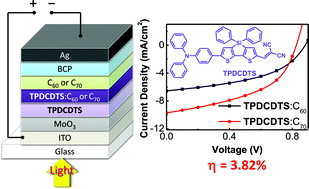A new donor–acceptor molecule with uniaxial anisotropy for efficient vacuum-deposited organic solar cells†
Abstract
A new D–π–A molecule (TPDCDTS) adopting coplanar diphenyl-substituted dithienosilole as a central π-bridge of

* Corresponding authors
a
Department of Materials Science and Engineering, National Tsing Hua University, Hsin Chu 30013, Taiwan
E-mail:
hwlin@mx.nthu.edu.tw
b
Department of Chemistry, National Taiwan University, Taipei 10617, Taiwan
E-mail:
kenwong@ntu.edu.tw
A new D–π–A molecule (TPDCDTS) adopting coplanar diphenyl-substituted dithienosilole as a central π-bridge of

 Please wait while we load your content...
Something went wrong. Try again?
Please wait while we load your content...
Something went wrong. Try again?
H. Lin, L. Lin, Y. Chen, C. Chen, Y. Lin, S. Chiu and K. Wong, Chem. Commun., 2011, 47, 7872 DOI: 10.1039/C1CC12139A
To request permission to reproduce material from this article, please go to the Copyright Clearance Center request page.
If you are an author contributing to an RSC publication, you do not need to request permission provided correct acknowledgement is given.
If you are the author of this article, you do not need to request permission to reproduce figures and diagrams provided correct acknowledgement is given. If you want to reproduce the whole article in a third-party publication (excluding your thesis/dissertation for which permission is not required) please go to the Copyright Clearance Center request page.
Read more about how to correctly acknowledge RSC content.
 Fetching data from CrossRef.
Fetching data from CrossRef.
This may take some time to load.
Loading related content
